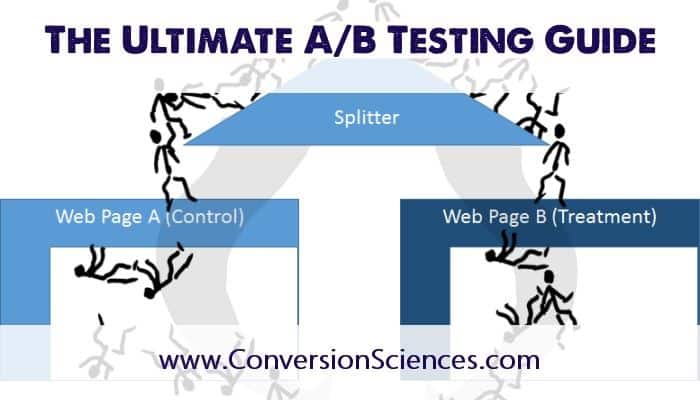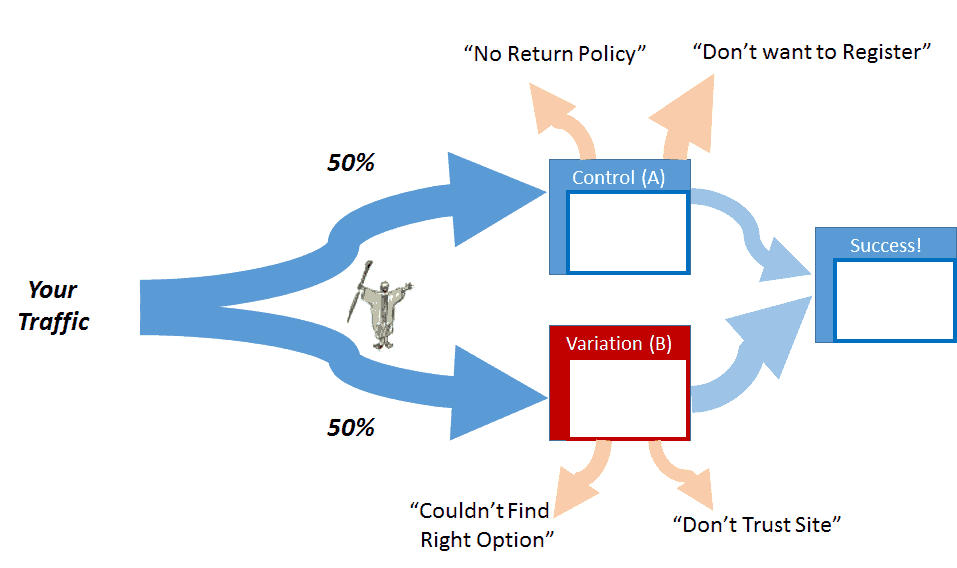Uncover the secrets to increasing your website’s success with the ultimate guide to AB testing – revolutionize your strategy now!

Image courtesy of via DALL-E 3
Table of Contents
Welcome, young readers! Today, we are embarking on an exciting journey to explore the world of AB Testing. Have you ever wondered how companies make decisions about what works best for their products or websites? That’s where AB Testing comes in! In this guide, we will learn all about AB Testing, how it can help optimize strategies, and why it’s essential in various fields.
What is AB Testing?
If you’re curious about what AB Testing actually means, you’re in the right place! AB Testing is a method used to compare two versions of something to see which one performs better. It’s like trying two different flavors of ice cream to see which one you like more. By testing different options, companies can figure out what works best and make informed decisions.
Why is AB Testing Important?
Now, you might be wondering, “Why is AB Testing so important?” Well, imagine you have a lemonade stand, and you want to know if more people prefer sweet lemonade or tangy lemonade. By using AB Testing, you can offer both options to customers and see which one sells more. This way, you can make sure to always serve the most popular lemonade and keep your customers happy!
Getting Started with AB Testing
Before diving into the world of AB testing, it’s essential to understand the basics of this powerful strategy. AB testing is a method used to compare two versions of something to determine which one performs better. It’s like choosing between two ice cream flavors to see which one is more popular among your friends.
Setting Up Your First AB Test
Now that you know what AB testing is, it’s time to set up your first test. Start by deciding what you want to test, such as different colors for a website button or varied wording for an email subject line. Once you have your elements in mind, gather the materials needed to create the two versions to compare.
Choosing What to Test
When selecting what to test, think about what will make the most significant impact on your desired outcome. This could be headlines, images, button sizes, or even the placement of elements on a page. Pick elements that are crucial to your objective and that have the potential to influence your results.
Designing Your Test
In order to conduct a successful AB test, it’s essential to carefully design the test parameters to ensure accurate results. Let’s delve into how you can effectively design your test by considering variables and control groups.
Variables and Control Groups
When setting up an AB test, it’s crucial to understand the concept of test variables and control groups. Test variables are the elements you are testing, such as different headlines, colors, or images on a webpage. These variables are the changes you are making to see which version performs better.
On the other hand, a control group is a set of users who are exposed to the existing version, without any changes. The control group serves as a benchmark to compare the test variables against, allowing you to measure the effectiveness of your changes accurately.
Creating Test Versions
Once you have identified the variables you want to test and established your control group, the next step is to create different versions for the test. Ensure that each version is distinct so that you can clearly measure the impact of your changes.
Make sure that the test versions are set up correctly and that they are ready for comparison. It’s important to keep the test conditions consistent across all versions to avoid any confounding factors that may skew the results.
Running Your Test
In this section, we will guide you through the process of running your AB test. Let’s dive in and learn how to conduct the test, determine its duration, and properly collect data for analysis.

Image courtesy of conversionsciences.com via Google Images
Conducting the Test
Once you have set up your AB test and designed your test versions, it’s time to run the test. Make sure to monitor the test closely to ensure everything goes smoothly. Keep an eye on any unexpected changes or technical issues that may arise during the test.
Determining Test Duration
Deciding on the duration of your AB test is essential to gather accurate results. Typically, a test should run for a minimum of one to two weeks to capture different patterns over time. However, the duration may vary depending on the complexity of the test and the traffic volume on your website.
Collecting Data
Collecting data accurately is crucial for analyzing the results of your AB test. Make sure to track relevant metrics such as click-through rates, conversion rates, and bounce rates. Utilize tools like Google Analytics to gather valuable data that will help you make informed decisions based on the test results.
Analyzing Results
In this section, we will delve into how to analyze the data collected from your AB test to determine which version was more successful. By interpreting the data and identifying key success metrics, you will gain valuable insights into the effectiveness of your strategies.
Interpreting Data
When it comes to analyzing the results of your AB test, it’s essential to look beyond the numbers. Take a closer look at the data and try to understand what it’s telling you. For example, if one version of your test significantly outperformed the other, try to identify the reasons behind this success. Look for patterns or trends in the data that can help you draw meaningful conclusions.
Identifying Success Metrics
Success metrics are the key performance indicators that help you determine the effectiveness of your test. These metrics can include click-through rates, conversion rates, or any other specific goals you set for your test. By analyzing these metrics, you can clearly see which version of your test resonated better with your audience and ultimately led to the desired outcome.
Applying Findings
After conducting your AB test and analyzing the results, it’s time to put those findings to good use. Applying the insights gained from your test can help you make better decisions and improve your overall strategy. Here’s how you can effectively apply your findings:

Image courtesy of conversionsciences.com via Google Images
Using the Data to Make Decisions
One of the key benefits of AB testing is that it provides you with concrete data that can guide your decision-making process. By analyzing the results of your test, you can determine which version performed better and why. This information can then be used to inform future strategies and initiatives. Whether it’s choosing between two marketing campaigns or deciding on website design elements, using the data from your AB test can help you make more informed decisions.
Improving Your Strategy
Once you have identified which version performed better in your AB test, it’s time to apply those learnings to improve your overall strategy. By incorporating the insights gained from the test, you can refine your approach and optimize your efforts for success. Whether it’s tweaking your email marketing tactics or adjusting your product pricing, using the findings from your AB test can lead to more effective strategies and better results.
Common Pitfalls and How to Avoid Them
As you embark on your AB Testing journey, it’s essential to be aware of common pitfalls that can derail your efforts. By recognizing these mistakes and knowing how to avoid them, you can ensure the success of your testing strategy.
Avoiding Test Bias
Test bias occurs when external factors influence the outcome of your test, leading to inaccurate results. To avoid this pitfall, it’s crucial to design your test in a way that minimizes bias. Ensure that your control group and test group are selected randomly and that external variables are kept constant. By maintaining a fair testing environment, you can trust the validity of your results.
Ensuring a Large Enough Sample Size
Having a large enough sample size is vital for obtaining reliable results from your AB Test. If your sample size is too small, the variations between your test groups may not be significant enough to draw valid conclusions. To avoid this pitfall, aim for a sample size that is statistically significant. Utilize online calculators or consult with a statistician to determine the appropriate sample size for your test. By ensuring a sufficient sample size, you can have confidence in the accuracy of your results.
Advanced AB Testing Tips
For those looking to elevate their AB testing game, there are some advanced tips and best practices that can help optimize the testing process. These strategies can enhance the accuracy and reliability of your tests, leading to more insightful results.

Image courtesy of conversionsciences.com via Google Images
Using Multivariate Testing
One advanced technique in the world of AB testing is multivariate testing. Unlike traditional AB testing, which compares only two versions of a variable, multivariate testing allows you to test multiple variables simultaneously. This means you can analyze the impact of several changes at once, giving you a more comprehensive view of how different elements interact with each other.
By using multivariate testing, you can uncover complex relationships between various elements on your website or in your marketing campaigns. This method can help you optimize your strategy by identifying the most effective combination of variables, rather than looking at each element in isolation.
Improving Test Accuracy
To ensure the accuracy of your AB tests, there are several best practices you can follow. One key tip is to run tests for a sufficient duration to gather significant data. Rushing through tests can lead to unreliable results, so it’s important to allow enough time for variations to show their impact.
Another way to improve test accuracy is to segment your audience effectively. By dividing your audience into distinct groups based on relevant criteria, you can gain a deeper understanding of how different demographics or user behaviors affect test outcomes. This segmentation can help you tailor your strategies more effectively to specific audience segments.
Conclusion
In conclusion, AB Testing is a powerful tool that can help individuals and businesses optimize their strategies for better results. By testing different versions of elements like headlines, images, or colors, you can gather valuable data to make informed decisions. Through this process, you can continually improve and refine your strategies for greater success.
Recap of Key Points
Throughout this guide, we’ve covered the basics of AB Testing, from understanding what it is to setting up your first test and analyzing the results. We’ve learned about the importance of variables, control groups, and how to interpret data to identify success metrics. By applying these findings, you can make better decisions and continually improve your strategies.
Encouragement to Begin Testing
Now that you have a solid understanding of AB Testing, we encourage you to start experimenting with your own tests. Whether you’re a marketer looking to optimize ad campaigns or a website owner aiming to improve user experience, AB Testing can help you achieve your goals. Remember, the more you test and learn, the better your strategies will become.
Want to turn these SEO insights into real results? Seorocket is an all-in-one AI SEO solution that uses the power of AI to analyze your competition and craft high-ranking content.
Seorocket offers a suite of powerful tools, including a Keyword Researcher to find the most profitable keywords, an AI Writer to generate unique and Google-friendly content, and an Automatic Publisher to schedule and publish your content directly to your website. Plus, you’ll get real-time performance tracking so you can see exactly what’s working and make adjustments as needed.
Stop just reading about SEO – take action with Seorocket and skyrocket your search rankings today. Sign up for a free trial and see the difference Seorocket can make for your website!
FAQs
What is a good sample size for AB Testing?
When talking about sample size in AB Testing, we are referring to the number of participants or data points needed to make your test results statistically significant. Having a good sample size ensures that your results are reliable and can be generalized to a larger population. If your sample size is too small, the results may not accurately reflect the true impact of your changes.
Typically, a good sample size for AB Testing should be large enough to detect differences between your test groups with statistical confidence. While the ideal sample size can vary depending on various factors, a rule of thumb is to aim for at least 100 participants per variation in your test. However, the actual sample size needed may differ based on the level of change you expect to see and the variability in your data.
How long should I run my AB Test?
The duration of your AB Test is crucial in ensuring that you collect enough data to make informed decisions. Running your test for too short a period may not provide sufficient data for meaningful results, while running it for too long could lead to unnecessary delays in implementing changes.
As a general guideline, it is recommended to run your AB Test for a minimum of one to two weeks to capture different trends and account for variations in daily traffic. However, the duration may need to be adjusted based on the traffic volume, frequency of conversions, and the magnitude of changes you are testing. Ideally, you should run the test until you reach statistical significance, ensuring that you have enough data to make a confident decision based on the results.







